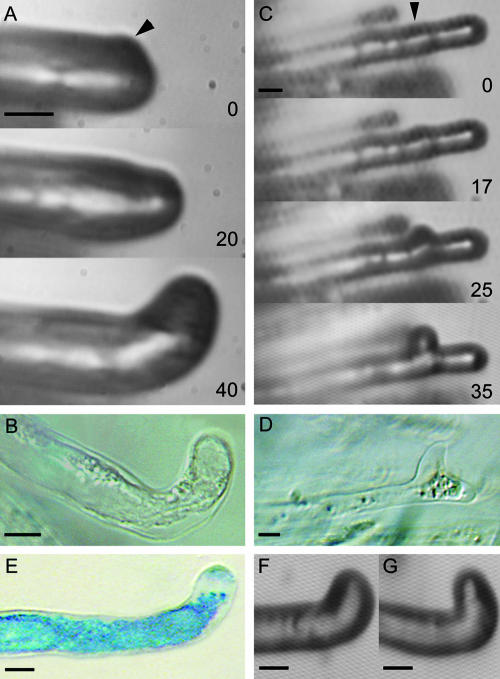Figure 8.
Responses of M. truncatula dmi2-1 ProMtENOD11:GUS Root Hairs to Spot Application of 10−9 M NF.
(A) Time series of reorientation of root hair growth after spot application of 10−9 M NF on the side of the tip of a growing M. truncatula dmi2-1 root hair. At 20 min, the reorientation is visible, and at 40 min, it is pronounced.
(B) Reoriented M. truncatula dmi2-1 root hair carrying the ProMtENOD11:GUS reporter gene, 60 min after spot application and 24 h after GUS reaction. In all of 13 root hairs, no GUS was detected, showing that the root hair does not express MtENOD11 after NF spot application.
(C) Time series of the formation of a root hair branch after spot application of 10−9 M NF 30 μm below the tip of a growing M. truncatula dmi2-1 root hair. At 17 min after application, the first sign of the formation of a branch is visible, which becomes more pronounced later in time.
(D) The same root hair as in (C), 60 min after spot application and 24 h after GUS reaction. In all five root hairs, no GUS was detected, showing that the root hairs do not express ProMtENOD11:GUS after NF spot application.
(E) ProMtENOD11:GUS expression in a wild-type root hair, 60 min after NF spot application and 24 h after GUS reaction. Clearly, the reorientation toward the site of application and the GUS expression are visible.
(F) Growing C71 (dmi1-1) root hair, 45 min after NF spot application.
(G) Growing TRV25 (dmi3-1) root hair, 55 min after NF spot application. Both the C71 and TRV25 root hairs show root hair reorientation toward the site of application in a timeframe comparable to wild-type root hairs.
Arrowheads point to the site of application, and bars = 10 μm.

